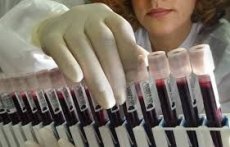Created artificial blood, suitable for transfusion to humans
Last reviewed: 23.04.2024

All iLive content is medically reviewed or fact checked to ensure as much factual accuracy as possible.
We have strict sourcing guidelines and only link to reputable media sites, academic research institutions and, whenever possible, medically peer reviewed studies. Note that the numbers in parentheses ([1], [2], etc.) are clickable links to these studies.
If you feel that any of our content is inaccurate, out-of-date, or otherwise questionable, please select it and press Ctrl + Enter.

A group of researchers from Edinburgh University has been developing a technology for the production of artificial blood for quite some time. Recently they managed to create such blood, which is normally taken by the human body. As the project manager Mark Turner noted, at the initial stage of the study patients will receive 5 ml of artificial blood, which should be enough to study the behavior of artificially created cells in the natural environment. Large-scale tests of artificial blood are scheduled for 2016, where three patients with a diagnosis of erythroblastic anemia (a disease requiring regular infusion of fresh blood) will participate.
It took specialists a few years to develop a technology in which a part of the stem cells became full red blood cells. In the laboratory, stem cells are placed in a special environment close to the natural environment of the human body, which facilitates the initiation of the formation of red blood cells. The effectiveness of this method, according to experts of the research group, is quite high: about 50% of stem cells grow into red corpuscles. In total, the process of creating artificial blood takes about a month. Separate suitable for further use of cells from immature can be in the usual way of blood separation, for example, using a centrifuge. Experts plan to produce artificial blood from a fairly rare type of blood - O, because this type is suitable for transfusion to virtually all patients. In the future, such artificially created blood can be much cheaper than donor blood.
Specialists suggest that after 20 years, artificial blood will replace blood donors and, with a successful experiment in 2016, you can talk about reaching the industrial level.
Stem cells have long been of interest to scientists. Recently, Russian specialists underwent an operation to transplant stem cells taken from umbilical cord blood. The operation was performed on a child with a diagnosis of retroperitoneal neuroblastoma, as a rule, with this disease the prognosis is unfavorable. The boy, who was diagnosed with this in 2005, underwent a stem cell transplant operation, which was taken from the umbilical cord blood of his brother, who was born during the boy's treatment, and he also transplanted the stem peripheral cells from his father. Now after the operation, almost 10 months have passed and physicians can say that the operation went well, the stem cells of the baby's body were taken and the boy's condition is quite satisfactory.
The younger brother by his appearance in the world saved the boy's life and now thanks to the doctors he is on the mend.
The operation performed by the Russian specialists of the cancer center is unique in its kind. In the world, a podlobnaya operation for stem cell transplantation from the father of a sick child was carried out. Now in Russia, only seven operations have been performed, during which stem cells from umbilical cord blood were transplanted to patients with oncology and blood diseases of varying severity. Details of the operation were written in the journal "Cellular Transplantology and Tissue Engineering."

 [
[